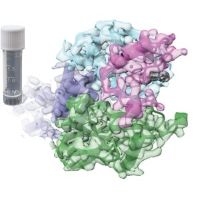Specification
| Description | Recombinant protein from the full-length sequence of Homo sapiens gasdermin E (GSDME), transcript variant 1 (NM_004403). |
| Organism | Homo sapiens (Human) |
| Expression Host | Human Cells |
| Tag Info | His or DYKDDDDK. Please contact us if you need further information or require specific designed tag. |
| Purity | Greater than 90% by SDS-PAGE gel |
| Uniprot ID | O60443 |
| Entry Name | GSDME_HUMAN |
| Gene Names | GSDME DFNA5 ICERE1 |
| Alternative Gene Names | DFNA5 ICERE1 |
| Alternative Protein Names | Gasdermin-E (Inversely correlated with estrogen receptor expression 1) (ICERE-1) (Non-syndromic hearing impairment protein 5) [Cleaved into: Gasdermin-E, N-terminal (GSDME-NT); Gasdermin-E, C-terminal (GSDME-CT)] |
| Application | Antigens, Western, ELISA and other in vitro binding or in vivo functional assays, and protein-protein interaction studies; For research & development use only! |
| Buffer | Purified protein formulated in a sterile solution of PBS buffer, pH7.2, without any preservatives |
| Endotoxin | Endotoxin level is < 0.1 ng/µg of protein (<1EU /µg) |
| Length | 496 |
| Molecular Weight(Da) | 54555 |
| Protein Sequence | (The sequence of expressed protein may have some variation from the sequence shown below. Please contact us for the exact sequence.) MFAKATRNFLREVDADGDLIAVSNLNDSDKLQLLSLVTKKKRFWCWQRPKYQFLSLTLGDVLIEDQFPSPVVVESDFVKYEGKFANHVSGTLETALGKVKLNLGGSSRVESQSSFGTLRKQEVDLQQLIRDSAERTINLRNPVLQQVLEGRNEVLCVLTQKITTMQKCVISEHMQVEEKCGGIVGIQTKTVQVSATEDGNVTKDSNVVLEIPAATTIAYGVIELYVKLDGQFEFCLLRGKQGGFENKKRIDSVYLDPLVFREFAFIDMPDAAHGISSQDGPLSVLKQATLLLERNFHPFAELPEPQQTALSDIFQAVLFDDELLMVLEPVCDDLVSGLSPTVAVLGELKPRQQQDLVAFLQLVGCSLQGGCPGPEDAGSKQLFMTAYFLVSALAEMPDSAAALLGTCCKLQIIPTLCHLLRALSDDGVSDLEDPTLTPLKDTERFGIVQRLFASADISLERLKSSVKAVILKDSKVFPLLLCITLNGLCALGREHS |
Background
| Function | FUNCTION: [Gasdermin-E]: Precursor of a pore-forming protein that converts non-inflammatory apoptosis to pyroptosis (PubMed:27281216, PubMed:28459430). This form constitutes the precursor of the pore-forming protein: upon cleavage, the released N-terminal moiety (Gasdermin-E, N-terminal) binds to membranes and forms pores, triggering pyroptosis (PubMed:28459430). {ECO:0000269|PubMed:27281216, ECO:0000269|PubMed:28459430}.; FUNCTION: [Gasdermin-E, N-terminal]: Pore-forming protein produced by cleavage by CASP3 or granzyme B (GZMB), which converts non-inflammatory apoptosis to pyroptosis or promotes granzyme-mediated pyroptosis, respectively (PubMed:27281216, PubMed:28459430, PubMed:32188940). After cleavage, moves to the plasma membrane, homooligomerizes within the membrane and forms pores of 10-15 nanometers (nm) of inner diameter, triggering pyroptosis (PubMed:28459430, PubMed:32188940). Binds to inner leaflet lipids, bisphosphorylated phosphatidylinositols, such as phosphatidylinositol (4,5)-bisphosphate (PubMed:28459430). Cleavage by CASP3 switches CASP3-mediated apoptosis induced by TNF or danger signals, such as chemotherapy drugs, to pyroptosis (PubMed:27281216, PubMed:28459430, PubMed:32188940). Mediates secondary necrosis downstream of the mitochondrial apoptotic pathway and CASP3 activation as well as in response to viral agents (PubMed:28045099). Exhibits bactericidal activity (PubMed:27281216). Cleavage by GZMB promotes tumor suppressor activity by triggering robust anti-tumor immunity (PubMed:21522185, PubMed:32188940). Suppresses tumors by mediating granzyme-mediated pyroptosis in target cells of natural killer (NK) cells: cleavage by granzyme B (GZMB), delivered to target cells from NK-cells, triggers pyroptosis of tumor cells and tumor suppression (PubMed:32188940, PubMed:31953257). May play a role in the p53/TP53-regulated cellular response to DNA damage (PubMed:16897187). {ECO:0000269|PubMed:16897187, ECO:0000269|PubMed:21522185, ECO:0000269|PubMed:27281216, ECO:0000269|PubMed:28045099, ECO:0000269|PubMed:28459430, ECO:0000269|PubMed:31953257, ECO:0000269|PubMed:32188940}. |
| Pathway | |
| Protein Families | Gasdermin family |
| Tissue Specificity | Expressed in cochlea (PubMed:9771715). Low level of expression in heart, brain, placenta, lung, liver, skeletal muscle, kidney and pancreas, with highest expression in placenta (PubMed:9771715). {ECO:0000269|PubMed:9771715}. |
QC Data
| Note | Please contact us for QC Data |
| Product Image (Reference Only) |  |

